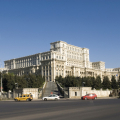PARLIAMENTARY BUILDING
The Parliament Palace (Palatul Parlamentului), an emblematic building in Bucharest, is the symbol of the megalomania of Ceaușescu. Its colossal silhouette stands in the heart of the capital, like a stinging reminder of this painful page of history. It is seen from above, from the Marriott for example, that it is the most imposing. Its location on the hill, added to the height of its walls, gives the impression that it crushes the city.
Built between 1984 and 1989, the building was then called the House of the People (Casa Poporului). It was supposed to house the main institutions, but its construction was interrupted by the revolution. The building as it stands today therefore remains unfinished. Its dimensions are impressive and it is difficult to mention it without a long list of numbers: it is the largest administrative building in Europe, the second largest in the world (after the Pentagon). With a surface area of 365,000 m², it is 270 metres long, 240 metres wide and 84 metres high, on 12 levels (plus 8 underground). The palace has more than a thousand rooms, of which the largest, the ballroom, is 2,200 m². Its gigantic carpet weighs 4 tons. The style is the one that prevails in most of the many villas that Ceaușescu have been built across the country: marble is omnipresent, as are gilding and chandeliers (there are 2,800 of them!).
Some 20,000 workers and 12,000 soldiers worked on its construction. Thousands of tons of materials were transported from all over the country: marble, crystal, cement, steel, wood... The House of the People was part of a larger project of systematization of the city: the Civic Centre (Centrul Civic), organized around the gigantic boulevard of the Victory of Socialism (today Unirii Boulevard), also included ministries and residential buildings for the communist elite.
To make room for this titanic construction site, a fifth of the city was razed to the ground, including valuable historical monuments such as the monastery Văcărești. Some 10,000 houses were demolished, particularly in the Uranus district, which was then full of charm with its cobbled streets and beautiful houses. The project consumed huge sums of money and contributed to the impoverishment of the population.
After the fall of the communist regime, the question was raised as to what function the building should be used for. There was talk of a hotel, a conference centre or simply destruction. Finally, the Chamber of Deputies was established there in 1994, followed by the Constitutional Court and the Senate, while the west wing houses the National Museum of Contemporary Art. The site also serves as an international conference centre. Rooms can even be rented for private events (including weddings, such as Nadia's Comăneci in 1996). However, a large part of the building is still unused and the maintenance of such a building is very expensive (more than 300 people work there daily).
Of course, the guided tour only takes you to a small part of the palace's rooms (about 5%), the most imposing ones. It lasts about 2 hours and is usually in English or Romanian, sometimes in French. For a small extra charge, you can add to the basic package a visit to the underground passages. Another, more expensive formula gives you access to the terrace on the eighth floor. Don't forget to bring an identity card.
Did you know? This review was written by our professional authors.
Members' reviews on PARLIAMENTARY BUILDING
The ratings and reviews below reflect the subjective opinions of members and not the opinion of The Little Witty.






It is the second largest single building in the world and a symbol of the Chauşescu dictatorship. Tours must be booked in advance by telephone and are best arranged by the hotel staff. On the day of the tour, visitors present their passport at the entrance and pay for the tour. The interior is opulent and is used for congresses and conventions. The tour lasts approximately one hour and also functions as a parliamentary building.